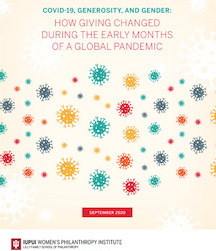Indiana University Report Examines Gender Differences in Philanthropy During the COVID-19 Pandemic
Posted on Sep 02, 2020 | Comments 0
 A new report from researchers at the Women’s Philanthropy Insitute at Indiana University in Bloomington examines how women and men gave in response to the pandemic and how their overall giving changed during spring 2020.
A new report from researchers at the Women’s Philanthropy Insitute at Indiana University in Bloomington examines how women and men gave in response to the pandemic and how their overall giving changed during spring 2020.
Around one-third of U.S. households gave directly to charitable organizations, individuals, or businesses in response to the COVID-19 pandemic during the initial months of the crisis. Households were more likely to decrease than increase their giving as a result of conditions present during the early months of the pandemic.
Single women were more likely than single men and married/partnered couples to decrease their giving as a result of specific elements of the COVID-19 pandemic during the initial months of the crisis. Nearly 40 percent of single women decreased their charitable giving during the first months of the pandemic compared to 30 percent of single men and 32 percent of married-couple households.
- One third of single women decreased their giving because they were uncertain about the further spread of COVID-19, compared with 24 percent of single men.
- Nearly 32 percent of single women reported that they reduced charitable donations due to a reduction in income because of social distancing and business shutdowns, compared with 23.4 percent of single men.
- Some 38 percent of single women reduced their giving due to uncertainty about the future economic impact of the virus. Less than 30 percent of single men reduced their giving for this reason.
- More than 21 percent of single women reported reducing their giving because the virus had infected family members or friends, compared to 14 percent of single men.
The full report, COVID-19, Generosity, and Gender: How Giving Changed During the Early Months of a Global Pandemic, may be downloaded by clicking here.
Filed Under: Research/Study








